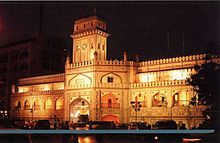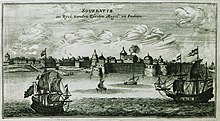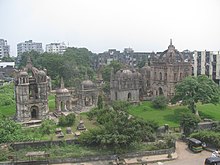
Gujarat is a state along the western coast of India. Its coastline of about 1,600 km (990 mi) is the longest in the country, most of which lies on the Kathiawar peninsula. Gujarat is the fifth-largest Indian state by area, covering some 196,024 km2 (75,685 sq mi); and the ninth-most populous state, with a population of 60.4 million in 2011. It is bordered by Rajasthan to the northeast, Dadra and Nagar Haveli and Daman and Diu to the south, Maharashtra to the southeast, Madhya Pradesh to the east, and the Arabian Sea and the Pakistani province of Sindh to the west. Gujarat's capital city is Gandhinagar, while its largest city is Ahmedabad. The Gujaratis are indigenous to the state and their language, Gujarati, is the state's official language.
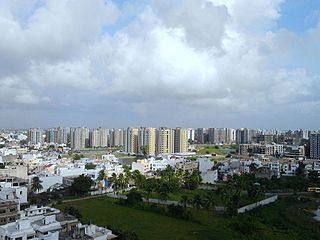
Surat is a city in the western Indian state of Gujarat. The word Surat literally means face in Gujarati and Hindi. Located on the banks of the river Tapti near its confluence with the Arabian Sea, it used to be a large seaport. It is now the commercial and economic center in South Gujarat, and one of the largest urban areas of western India. It has well-established diamond and textile industry, and is a major supply centre for apparels and accessories. About 90% of the world's diamonds are cut and polished in Surat. It is the second largest city in Gujarat after Ahmedabad and the eighth largest city by population and ninth largest urban agglomeration in India. It is the administrative capital of the Surat district. In recent years, Surat has been noted for achieving a Guinness World Record for the largest gathering for a yoga session at one place where 153,000 people joined the event on International Yoga Day.
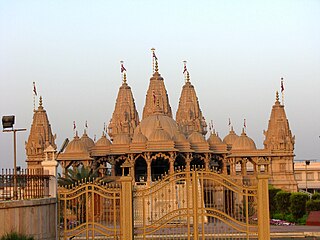
Bharuch, known in ancient times as Bharutkutccha, is a city at the mouth of the river Narmada in Gujarat in western India. Bharuch is the administrative headquarters of Bharuch District.
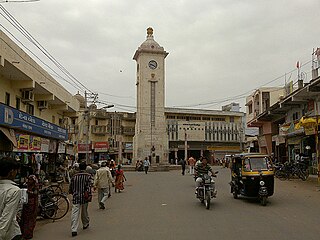
Khambhat, also known as Cambay, is a city and the surrounding urban agglomeration in Anand district in the Indian state of Gujarat. It was once an important trading center, but its harbour gradually silted up, and the maritime trade moved to Surat. Khambat lies on an alluvial plain at the north end of the Gulf of Khambhat, noted for the extreme rise and fall of its tides, which can vary as much as thirty feet in the vicinity of Khambat. Khambat is known for its halvasan sweet, sutarfeni, akik stone and kites (patang), and for sources of oil and gas.

Chaul is a historic town located in the Raigad district of Maharashtra, India. The Korlai Fort is located nearby.

Nashik district, also known as Nasik district, is a district in Maharashtra, India. The city of Nashik is the administrative headquarters of the district. Nashik is well known for the production of wine. Nashik is also known as Mini Maharashtra, because the climate and soil conditions of Surgana, Peth, Igatpuri resembles with Konkan. Niphad, Sinnar, Dindori, Baglan blocks are like Western Maharashtra and Yeola, Nandgaon, Chandwad blocks are like Vidarbha Region. Nashik is the biggest city in the district while Malegaon is the second biggest city. Manmad, Igatpuri, and Sinnar are some of the big cities situated in the Nashik District. Manmad is one of the biggest railway junctions in India while the city of Malegaon is famous for its powerloom.
The history of Gujarat began with Stone Age settlements followed by Chalcolithic and Bronze Age settlements like Indus Valley civilisation. Gujarat's coastal cities, chiefly Bharuch, served as ports and trading centers in the Nanda, Maurya, Satavahana and Gupta empires as well as during the Western Kshatrapas period. After the fall of the Gupta empire in the 6th century, Gujarat flourished as an independent Hindu-Buddhist state. The Maitraka dynasty, descended from a Gupta general, ruled from the 6th to the 8th centuries from their capital at Vallabhi, although they were ruled briefly by Harsha during the 7th century. The Arab rulers of Sindh sacked Vallabhi in 770, bringing the Maitraka dynasty to an end. The Gurjara-Pratihara Empire ruled Gujarat after from the 8th to 10th centuries. While the region also came under the control of the Rashtrakuta Empire. In 775 the first Parsi (Zoroastrian) refugees arrived in Gujarat from Greater Iran.

Battle of Surat, also known as the Sack of Surat, was a land battle that took place on 5 January 1664, near the city of Surat, in present-day Gujarat, India, between Shivaji, leader of the Mahratta Confederacy and Inayat Khan, a Moghal commander. The Marathas defeated the Moghal military unit posted at Surat and ransacked the city.
Mercenaries in India were fighters, primarily peasants, who came from India and abroad, to fight for local rulers in India in the medieval period. This mercenary work became an important source of income for some communities.
The term Gujarati Muslim is usually used to signify an Indian Muslim from the state of Gujarat in western coast of India. Most Gujarati Muslims have the Gujarati language as their mother tongue, but some communities have Urdu as their mother tongue. The vast majority of Gujarati Muslims are Sunni Muslims.

Malik Ayyaz, called Meliqueaz by the Portuguese, was a naval officer and governor of the city of Diu, in the mouth of the Gulf of Khambhat (Cambay), circa 1507–1509 under the rule of Gujarat Sultanate. He was one of the most distinguished warriors of his time.

GujaratiPathans are a group of Pashtuns, who are settled in the region of Gujarat in western India. They now form a distinct community of Gujarati and Urdu/Hindi speaking Muslims. They mainly speak Urdu/Hindi with many Pashto loanwords, but most of them have been Indianized so some may have Gujarati as their first language as well, few elders in the community still speak Pashto. Common tribes include Babi or Babai, Niazi, Khan, Bangash, Durrani, and Yousafzai.

The Bengal Subah, also referred to as Mughal Bengal, was the largest subdivision of Mughal India encompassing much of the Bengal region, which includes modern-day Bangladesh, the Indian state of West Bengal, and some parts of the present-day Indian states of Bihar, Jharkhand and Odisha between the 16th and 18th centuries. The state was established following the dissolution of the Bengal Sultanate, a major trading nation in the world, when the region was absorbed into the Mughal Empire. Bengal was the wealthiest region in the Indian subcontinent.
Virji Vora was an Indian merchant from Surat during the Mughal era. The East India Company Factory Records describe him as the richest merchant in the world at the time. According to English records, his personal worth is estimated to be worth 8 million rupees, a substantial amount of money at the time. He has been variously described as a "merchant prince," and a "plutocrat."
Rander is a town in Surat district in the state of Gujarat, India. Located on the bank of the Tapti River, it is 2 kilometres (1.2 mi) from the city of Surat.

Gopi Talav or Gopi Lake is a lake in the Gopipura locality in the city of Surat in Gujarat state of India. It was built circa 1510 CE by Malik Gopi, who was an affluent merchant and governor of Surat during the Gujarat Sultanate. In 2012, the lake was renovated by Surat Municipal Corporation and the area surrounding redeveloped as a recreational facility.

The Gujarat Subah was a province (subah) of the Mughal Empire, encompassing the Gujarat region. The region first fell under Mughal control in 1573, when the Mughal emperor Akbar defeated the Gujarat Sultanate under Muzaffar Shah III. Muzaffar tried to regain the Sultanate in 1584 but failed. Gujarat remained the Mughal province governed by the viceroys and officers appointed by the Mughal emperors from Delhi. Akbar's foster brother Mirza Aziz Kokaltash was appointed as the subahdar (viceroy) who strengthened Mughal hold over the region. The nobles of former Sultanate continued to resist and rebel during the reign of the next emperor Jahangir (1605–1627) but Kokaltash and his successor subahdars subdued them. Jehangir also permitted the British East India Company to establish factories in Surat and elsewhere in Gujarat. The next emperor Shah Jahan (1627–1658) expanded his territories in south and his subahdars made hold over Kathiawar peninsula including Nawanagar. Shah Jahan had also appointed his prince Aurangzeb, who was involved in religious disputes, prince Dara Shikoh and later prince Murad Bakhsh as subahdars. Following battle of succession, Aurangzeb (1658–1707) came to the Mughal throne and his policies resulted in revolts and discontent. During his reign, the Marathas under Shivaji raided Surat (1666) and their incursions in Gujarat started. Till then Gujarat prospered due to political stability, peace and growing international trade.
This article is a timeline of the city Surat in Gujarat For a more comprehensive overview of Surat's history, please see History of Surat.

Gujarati–Portuguese conflicts refers to the armed engagements between the Portuguese Empire and the Sultanate of Gujarat, in India, that took place from 1508 until Gujarat was annexed by the Mughal Empire in 1573.
Mughal–Portuguese conflicts refers to the various armed engagements between the forces of the Portuguese Empire in India and the Mughal Empire, between the 16th century and the 18th century.
